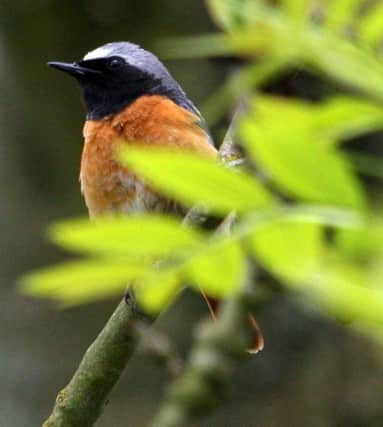Birdwatch: Oak nesting visitors make striking apperances


Redstart means red tail from Old English ‘steort’ and that is one of the most striking features of this bird. It can be hard to see among the newly emerging leaves but even the briefest of glimpses reveals the long bright rusty-red tail, constantly flicking, that is a feature in both sexes.
The male redstart is one of the most beautiful of our summer visitors with a red breast and a bold black mask edged at the top with white. His song is a short, sweet warble with a tinny ending.
Advertisement
Hide AdAdvertisement
Hide AdPied flycatchers are slightly smaller and, as their name suggests, fly out from a branch to catch insects. During the breeding season males are a smart black above and shining white beneath with a white wing bar and the females brown where the male is black. But as soon as they have finished nesting the males turn brown like the females and it is impossible to tell the two sexes apart as they migrate south to Africa each autumn.
Both species are especially common in the oak woodlands of Wales where two-fifths of the UK’s pied flycatcher population nests - in Yorkshire they are more localized.
Both are hole nesters and these can be hard to find in managed woodlands these days. But both take readily to nest boxes and many hundreds of these have been put up across the region to help them.
Perhaps one of the best known places to look for both species is in the ancient oak woods surrounding the Strid in Upper Wharfedale while redstarts are often reported along the newly emerged River Aire by birders on their way to the RSPB viewpoint at Malham Cove to watch the peregrine falcons there. The viewpoint is open every Saturday to Wednesday until July 30.
Advertisement
Hide AdAdvertisement
Hide AdSightings over Easter included a red-rumped swallow first seen over the Cut at Fairburn Ings on Sunday and still ranging over Village and Main Bays on the reserve the next day. There have been several of them, overshooting from southern Europe, across England this week.
Spoonbills were also at Fairburn Ings and the North Cave Wetlands, East Yorkshire. A male Western sub Alpine warbler, first caught and ringed at Spurn on April 7, reappeared on Sunday singing and calling along the canal and was still there the following day while an Iberian chiffchaff, the second at Spurn this spring and found by the same birder, was also along the canal.
Other migrants included the first whinchats, whitethroats and lesser whitethroats, hobby, common sandpipers and Arctic terns, and more yellow and white wagtails. A curlew sandpiper was at North Cave.
A Bewick’s swan was present with 25 whooper swans at the St Aidan’s reserve, Leeds, this week. Will it continue with them back to Icelandic breeding grounds or somehow link up with other Bewick’s swans before they return to northern Siberia for the summer?